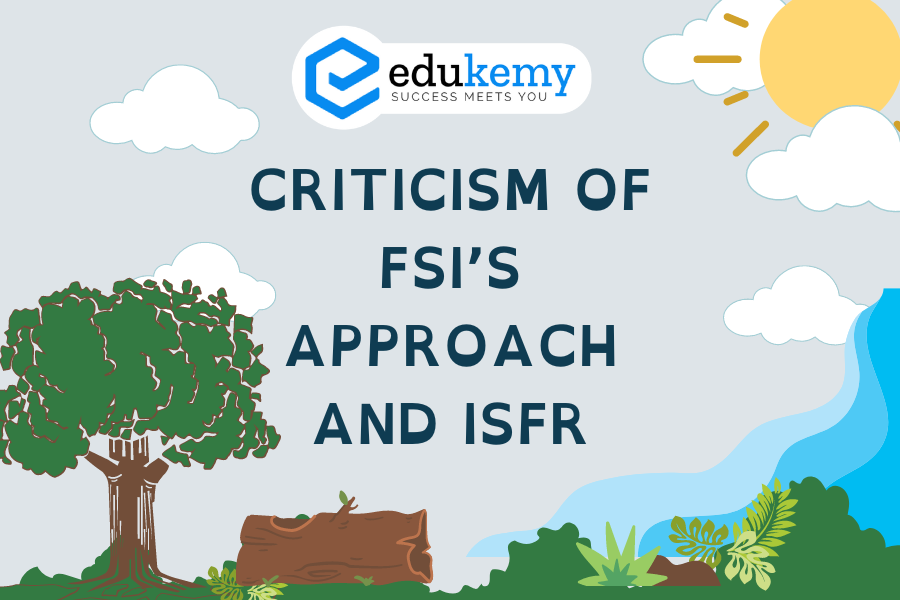- FSI has proactively embraced technological advancements to cater to the evolving information requirements of the forestry sector, leading to enhanced precision in findings.
Contents
- 1 Several pioneering initiatives in this regard include:
- 2 FAQs: FSI’s Innovative Initiatives in IFSR
- 2.1 1. What is the significance of the “Trees Outside Forest Resources in India” initiative?
- 2.2 2. How is FSI contributing to India’s Nationally Determined Contribution (NDC) for Carbon Sink?
- 2.3 3. What insights does the “Variability in Forests and Optimum Sample Size” study provide?
- 2.4 4. What is the significance of the “Grid Vegetation Change Index (GVCI)” introduced by FSI?
- 2.5 5. How has FSI been monitoring and assessing fire-affected forest areas since 2004?
- 3 In case you still have your doubts, contact us on 9811333901.
Several pioneering initiatives in this regard include:
Trees Outside Forest Resources in India:
- A novel methodology has been devised to accurately estimate Trees Outside Forest (TOF) resources and determine the extent of TOF areas across the country.
- Additionally, the potential annual timber yield from TOF has been meticulously assessed, contributing to a comprehensive understanding of this crucial resource.
India’s Nationally Determined Contribution for Carbon Sink:
- FSI has actively engaged in supporting India’s ambitious Nationally Determined Contribution, aiming to create an additional carbon sink of 2.5 to 3 billion tonnes of CO2 equivalent through augmented forest and tree cover.
- This involves exploring possibilities, evaluating scale, and estimating costs to formulate a strategic approach.
Variability in Forests and Optimum Sample Size:
- A comprehensive study has been conducted to determine the optimal sample size for estimating the Growing Stock in different districts of the country.
- This valuable resource serves as a ready reckoner for entities involved in Working Plan preparation and various forest resource assessment exercises, offering practical insights for State Forest Departments.
Grid Vegetation Change Index (GVCI):
- FSI has introduced a groundbreaking grid-based algorithm utilizing the Grid Vegetation Change Index (GVCI) to detect changes in forest vegetation with pinpoint accuracy across expansive landscapes.
- This innovative approach enables rapid identification of vegetation changes over specific areas between two distinct time periods, enhancing operational efficiency.
Rapid Assessment of Fire-Affected Forest Areas:
- Since 2004, FSI has been at the forefront of monitoring forest fires through remote sensing techniques, issuing timely alerts to State Forest Departments.
- The institute has developed a cost-effective and time-efficient methodology for the rapid assessment of forest areas affected by fires.
- This assessment aids in estimating the extent of fire-affected areas, facilitating strategic planning for eco-restoration activities by state authorities.
- The methodology takes advantage of the distinct signatures of fire-burnt areas on satellite images, ensuring a swift and accurate evaluation.
FAQs: FSI’s Innovative Initiatives in IFSR
1. What is the significance of the “Trees Outside Forest Resources in India” initiative?
A: The Trees Outside Forest (TOF) initiative involves a pioneering methodology developed by FSI to precisely estimate TOF resources and determine their extent nationwide. Additionally, the initiative assesses the potential annual timber yield from TOF, contributing to a comprehensive understanding of this vital resource.
2. How is FSI contributing to India’s Nationally Determined Contribution (NDC) for Carbon Sink?
A: FSI is actively supporting India’s NDC by aiming to create an additional carbon sink of 2.5 to 3 billion tonnes of CO2 equivalent through enhanced forest and tree cover. The initiative involves exploring possibilities, evaluating scale, and estimating costs to formulate a strategic approach.
3. What insights does the “Variability in Forests and Optimum Sample Size” study provide?
A: FSI conducted a comprehensive study to determine the optimal sample size for estimating the Growing Stock in different districts of the country. This valuable resource serves as a ready reckoner for entities involved in Working Plan preparation and various forest resource assessment exercises, offering practical insights for State Forest Departments.
4. What is the significance of the “Grid Vegetation Change Index (GVCI)” introduced by FSI?
A: FSI has introduced the GVCI, a groundbreaking grid-based algorithm, to detect changes in forest vegetation with pinpoint accuracy across expansive landscapes. This innovative approach enables the rapid identification of vegetation changes over specific areas between two distinct time periods, thereby enhancing operational efficiency.
5. How has FSI been monitoring and assessing fire-affected forest areas since 2004?
A: FSI has been at the forefront of monitoring forest fires through remote sensing techniques, issuing timely alerts to State Forest Departments. The institute has developed a cost-effective and time-efficient methodology for the rapid assessment of forest areas affected by fires. This assessment aids in estimating the extent of fire-affected areas and facilitates strategic planning for eco-restoration activities by state authorities, utilizing distinct signatures of fire-burnt areas on satellite images for swift and accurate evaluation.
In case you still have your doubts, contact us on 9811333901.
For UPSC Prelims Resources, Click here
For Daily Updates and Study Material:
Join our Telegram Channel – Edukemy for IAS
- 1. Learn through Videos – here
- 2. Be Exam Ready by Practicing Daily MCQs – here
- 3. Daily Newsletter – Get all your Current Affairs Covered – here
- 4. Mains Answer Writing Practice – here

